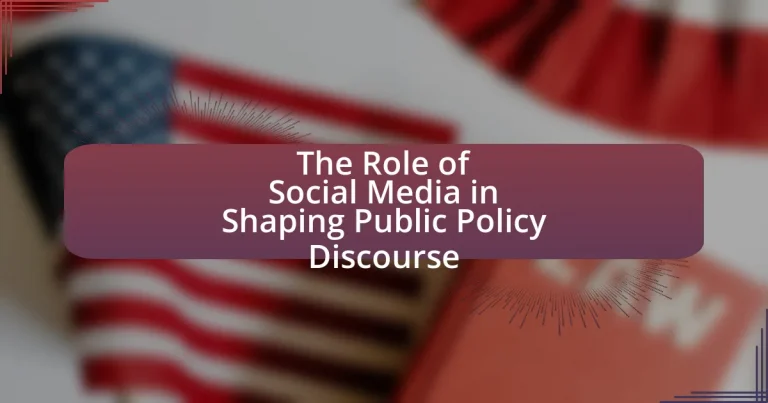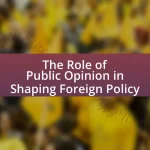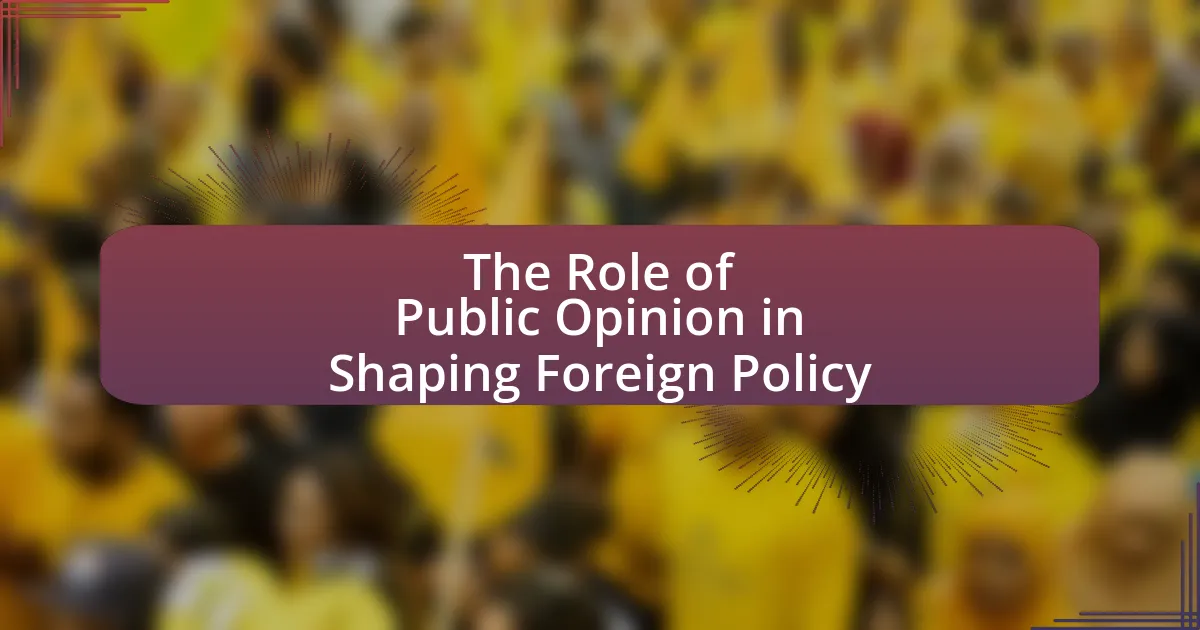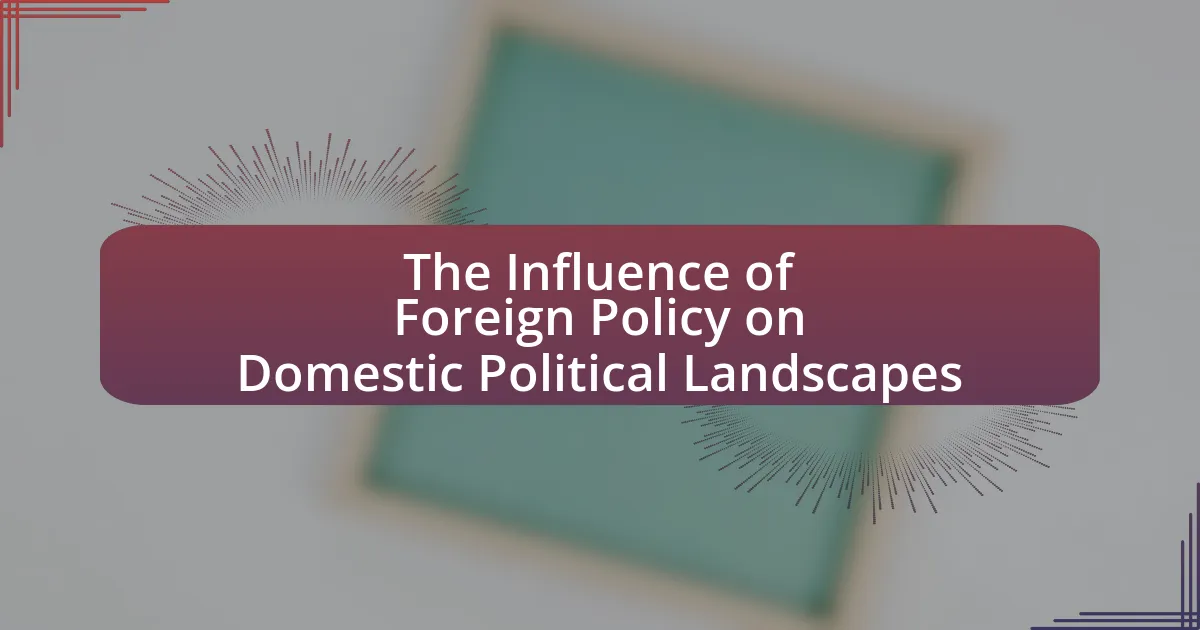The article examines the significant role of social media in shaping public policy discourse, highlighting its function as a platform for real-time communication between policymakers, stakeholders, and the public. It discusses how social media transforms public policy discussions by enabling broader participation and influencing public opinion, as evidenced by movements like the Arab Spring and #MeToo. Key platforms such as Twitter, Facebook, and LinkedIn are identified for their impact on policy engagement, while challenges like misinformation and echo chambers are also addressed. The article further explores the implications of social media algorithms, the role of influencers, and future trends in digital engagement with public policy.

What is the Role of Social Media in Shaping Public Policy Discourse?
Social media plays a crucial role in shaping public policy discourse by facilitating real-time communication and engagement between policymakers, stakeholders, and the public. This platform allows diverse voices to contribute to discussions, influencing policy agendas and decisions. For instance, studies have shown that social media campaigns can mobilize public opinion, as seen in the Arab Spring, where platforms like Twitter and Facebook were instrumental in organizing protests and drawing international attention to political issues. Additionally, research from the Pew Research Center indicates that 69% of adults in the U.S. use social media, highlighting its significance as a tool for information dissemination and public engagement in policy matters.
How has social media transformed public policy discussions?
Social media has transformed public policy discussions by enabling real-time communication and engagement between policymakers and the public. This shift allows for broader participation, as platforms like Twitter and Facebook facilitate the rapid dissemination of information and opinions, making it easier for citizens to voice their concerns and influence policy decisions. For instance, the Arab Spring demonstrated how social media mobilized public sentiment and organized protests, directly impacting governmental responses. Additionally, studies indicate that social media can shape public opinion and agenda-setting, as seen in the 2016 U.S. presidential election, where platforms played a crucial role in framing policy debates and voter priorities.
What are the key platforms influencing public policy discourse?
Key platforms influencing public policy discourse include Twitter, Facebook, and LinkedIn. Twitter serves as a real-time communication tool where policymakers, journalists, and the public engage in discussions, shaping narratives and public opinion. Facebook facilitates broader community engagement and mobilization around policy issues, allowing for grassroots movements to gain traction. LinkedIn, primarily a professional networking site, enables discussions among industry leaders and policymakers, influencing policy through professional insights and expertise. These platforms collectively impact how information is disseminated and debated, thereby shaping public policy discourse.
How do social media algorithms impact the visibility of policy-related content?
Social media algorithms significantly influence the visibility of policy-related content by prioritizing engagement metrics over informational value. These algorithms often favor posts that generate likes, shares, and comments, which can lead to the amplification of sensational or emotionally charged content while marginalizing nuanced policy discussions. For instance, a study by the Pew Research Center found that algorithm-driven feeds can create echo chambers, where users are exposed primarily to viewpoints that align with their own, reducing the diversity of policy-related information available to them. This selective exposure can hinder informed public discourse on critical policy issues, as users may not encounter a balanced range of perspectives necessary for comprehensive understanding.
Why is social media important in the context of public policy?
Social media is important in the context of public policy because it serves as a platform for real-time communication and engagement between policymakers and the public. This interaction allows for the dissemination of information, feedback collection, and mobilization of public opinion, which can influence policy decisions. For instance, studies have shown that social media campaigns can significantly impact public awareness and legislative outcomes, as seen in movements like #MeToo and climate change activism, where online discussions translated into policy action.
What role does social media play in citizen engagement with policy issues?
Social media serves as a crucial platform for citizen engagement with policy issues by facilitating communication, information sharing, and mobilization. It enables individuals to express their opinions, participate in discussions, and organize collective actions, thereby enhancing democratic participation. For instance, studies show that social media campaigns can significantly influence public opinion and policy decisions, as seen in movements like the Arab Spring, where platforms like Twitter and Facebook were instrumental in mobilizing citizens for political change. Additionally, research indicates that 70% of Americans use social media to engage with political content, highlighting its role in shaping public discourse and increasing awareness of policy issues.
How does social media facilitate the dissemination of information about public policies?
Social media facilitates the dissemination of information about public policies by providing a rapid and accessible platform for communication and engagement. Through platforms like Twitter, Facebook, and Instagram, government agencies, advocacy groups, and citizens can share updates, analyses, and opinions on policy matters instantly. For instance, a study by the Pew Research Center found that 69% of adults in the U.S. use social media, which allows for widespread reach and engagement with policy discussions. Additionally, social media enables real-time feedback and dialogue, allowing policymakers to gauge public sentiment and adjust their strategies accordingly. This dynamic interaction enhances transparency and encourages civic participation, ultimately shaping public policy discourse.
What challenges does social media present to public policy discourse?
Social media presents significant challenges to public policy discourse by amplifying misinformation and creating echo chambers. Misinformation can spread rapidly on platforms like Twitter and Facebook, leading to public confusion and misinformed opinions on policy issues. A study by the Pew Research Center found that 64% of Americans believe that fake news has caused a great deal of confusion about the basic facts of current events. Additionally, echo chambers foster polarization, as users often engage only with content that reinforces their existing beliefs, limiting constructive dialogue. This environment can hinder policymakers’ ability to gauge public opinion accurately and complicate consensus-building efforts.
How does misinformation on social media affect public understanding of policies?
Misinformation on social media significantly distorts public understanding of policies by spreading false narratives that can lead to confusion and misinterpretation. Studies indicate that exposure to misinformation can result in individuals forming incorrect beliefs about policy issues, as evidenced by a 2020 study published in the journal “Science Advances,” which found that misinformation can lead to a 20% increase in public misunderstanding of health policies during crises. This distortion occurs because social media platforms often prioritize sensational content, which can overshadow accurate information, thereby influencing public opinion and policy discourse negatively.
What are the implications of echo chambers in social media for policy discussions?
Echo chambers in social media significantly distort policy discussions by reinforcing existing beliefs and limiting exposure to diverse viewpoints. This phenomenon leads to polarization, where individuals become more entrenched in their positions, reducing the likelihood of compromise or consensus. Research indicates that echo chambers can amplify misinformation, as users are more likely to share content that aligns with their views, further entrenching biases. A study by the Pew Research Center found that 62% of social media users encounter news that reinforces their existing beliefs, which can hinder informed public discourse and effective policymaking.
How do policymakers utilize social media in their strategies?
Policymakers utilize social media to engage with constituents, disseminate information, and shape public discourse. By leveraging platforms like Twitter and Facebook, they can communicate directly with the public, gather feedback, and respond to concerns in real-time. For instance, during the COVID-19 pandemic, many government officials used social media to share updates, guidelines, and health information, effectively reaching millions instantly. This direct communication helps policymakers gauge public sentiment and adjust their strategies accordingly, demonstrating the significant impact of social media on public policy engagement and responsiveness.
What are the best practices for engaging the public on social media regarding policy issues?
The best practices for engaging the public on social media regarding policy issues include using clear and accessible language, actively listening to public feedback, and providing timely updates on policy developments. Clear language ensures that complex policy issues are understandable to a broad audience, which is essential for effective communication. Actively listening to public feedback fosters a two-way dialogue, allowing policymakers to gauge public sentiment and adjust their approaches accordingly. Timely updates keep the public informed and engaged, which is crucial for maintaining interest and trust in policy discussions. Research by the Pew Research Center indicates that 69% of adults in the U.S. use social media, highlighting its importance as a platform for public engagement on policy matters.
How can policymakers effectively address concerns raised on social media?
Policymakers can effectively address concerns raised on social media by actively engaging with the public through transparent communication and responsive action. This involves monitoring social media platforms to identify key issues, responding promptly to misinformation, and incorporating public feedback into policy development. For instance, a study by the Pew Research Center found that 69% of adults believe social media is an important tool for civic engagement, highlighting its role in shaping public discourse. By utilizing social media analytics and fostering dialogue, policymakers can build trust and ensure that community concerns are reflected in policy decisions.
What strategies can be employed to enhance constructive dialogue on social media?
To enhance constructive dialogue on social media, strategies such as promoting active listening, encouraging respectful discourse, and utilizing fact-checking resources can be employed. Active listening involves users genuinely engaging with others’ viewpoints, which fosters understanding and reduces hostility. Encouraging respectful discourse means setting clear community guidelines that discourage personal attacks and promote civil conversation. Utilizing fact-checking resources helps to ensure that discussions are based on accurate information, thereby reducing the spread of misinformation. Research indicates that platforms that implement these strategies see a significant increase in constructive interactions, as evidenced by studies showing that respectful engagement leads to more productive discussions and better outcomes in public policy discourse.
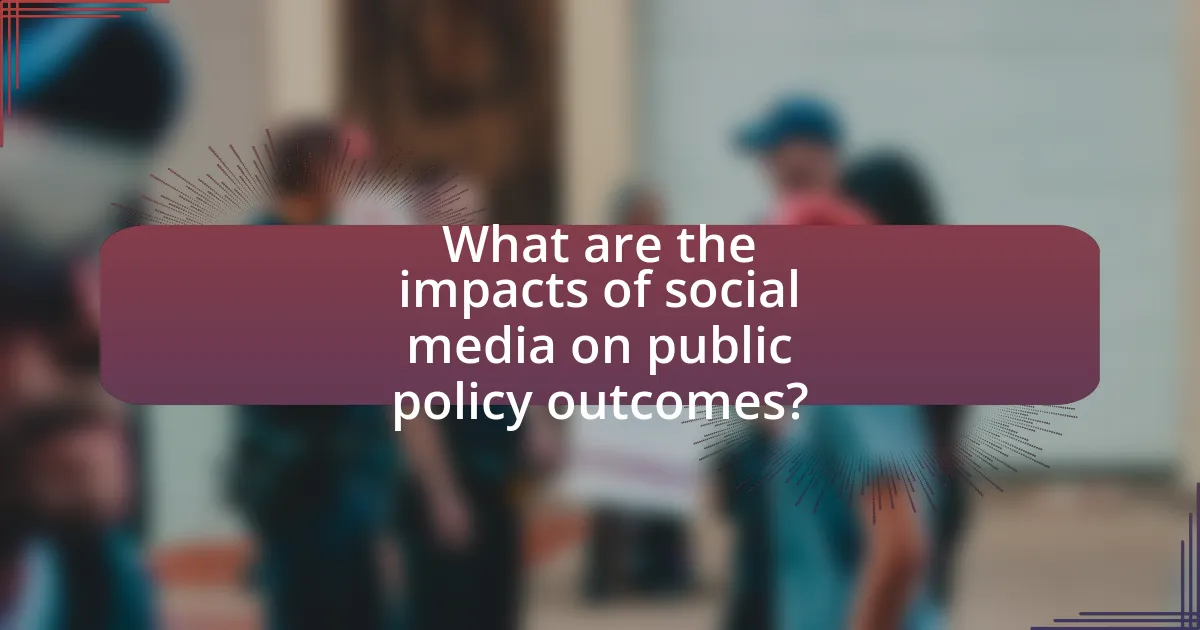
What are the impacts of social media on public policy outcomes?
Social media significantly influences public policy outcomes by facilitating rapid information dissemination and enabling citizen engagement. Platforms like Twitter and Facebook allow individuals and organizations to mobilize support, share opinions, and influence policymakers directly. For instance, the #MeToo movement on social media led to legislative changes regarding sexual harassment laws in various jurisdictions, demonstrating how online discourse can translate into tangible policy shifts. Additionally, studies show that social media can amplify marginalized voices, leading to increased awareness and responsiveness from policymakers. This dynamic interaction between social media and public policy highlights the growing importance of digital platforms in shaping governance and societal norms.
How does social media influence public opinion on policy matters?
Social media significantly influences public opinion on policy matters by facilitating rapid information dissemination and enabling direct engagement between policymakers and the public. Platforms like Twitter and Facebook allow users to share opinions, mobilize support, and amplify messages, which can shape perceptions and attitudes toward specific policies. For instance, a study by the Pew Research Center found that 64% of Americans believe social media has a major impact on their political views, highlighting its role in shaping public discourse. Additionally, social media campaigns can lead to increased awareness and activism around policy issues, as seen in movements like #BlackLivesMatter, which have influenced public policy discussions and legislative changes.
What metrics can be used to measure social media’s impact on policy change?
Metrics that can be used to measure social media’s impact on policy change include engagement rates, sentiment analysis, reach and impressions, and the volume of discussions related to specific policy issues. Engagement rates, which encompass likes, shares, and comments, indicate how actively users are participating in conversations about policy. Sentiment analysis assesses the emotional tone of social media posts, revealing public opinion trends regarding policy proposals. Reach and impressions measure how many people have seen content related to policy change, providing insight into the visibility of advocacy efforts. The volume of discussions, often tracked through hashtags or keywords, quantifies the level of public discourse surrounding a policy issue, which can correlate with shifts in policy decisions. These metrics collectively provide a comprehensive view of social media’s influence on policy change.
How do viral campaigns on social media affect legislative processes?
Viral campaigns on social media significantly influence legislative processes by amplifying public awareness and mobilizing grassroots support for specific issues. These campaigns can lead to increased pressure on lawmakers to respond to constituents’ concerns, as seen in movements like #MeToo and climate activism, which have prompted legislative discussions and actions. Research indicates that social media can shape public opinion rapidly, with platforms enabling the dissemination of information and mobilization of supporters, thereby affecting the legislative agenda and priorities. For instance, a study by the Pew Research Center found that 69% of Americans believe social media is an effective tool for raising awareness about political issues, demonstrating its impact on legislative responsiveness.
What role do influencers play in shaping public policy discourse on social media?
Influencers play a significant role in shaping public policy discourse on social media by amplifying messages, mobilizing audiences, and framing issues. Their large followings allow them to reach diverse demographics quickly, making them effective in raising awareness about specific policies or social issues. For instance, influencers have been instrumental in campaigns related to climate change, where they have used platforms like Instagram and Twitter to advocate for policy changes and engage their followers in discussions. Research indicates that social media influencers can sway public opinion, as seen in studies showing that 70% of young people trust influencers more than traditional celebrities or politicians. This trust translates into increased engagement and action, further impacting public policy discussions.
How can influencers mobilize public support for specific policies?
Influencers can mobilize public support for specific policies by leveraging their social media platforms to raise awareness and engage their audiences. They utilize targeted messaging, storytelling, and visual content to highlight the importance of particular issues, making them relatable and urgent. For instance, influencers often collaborate with advocacy groups to disseminate factual information and personal narratives that resonate with their followers, thereby fostering a sense of community and shared purpose. Research indicates that social media campaigns led by influencers can significantly increase public engagement; a study by the Pew Research Center found that 69% of adults in the U.S. use social media, making it a powerful tool for influencing public opinion and policy discussions.
What are the ethical considerations surrounding influencers in policy discussions?
Influencers in policy discussions raise several ethical considerations, primarily concerning transparency, accountability, and the potential for misinformation. Transparency is crucial as influencers often have undisclosed financial relationships with brands or political entities, which can bias their opinions and mislead their audience. Accountability is another concern; influencers may lack the expertise to discuss complex policy issues, leading to oversimplification or misrepresentation of facts. Furthermore, the rapid spread of information on social media can facilitate the dissemination of misinformation, impacting public understanding and trust in policy matters. These ethical considerations highlight the need for clear guidelines and standards for influencers engaging in policy discussions to ensure responsible communication.
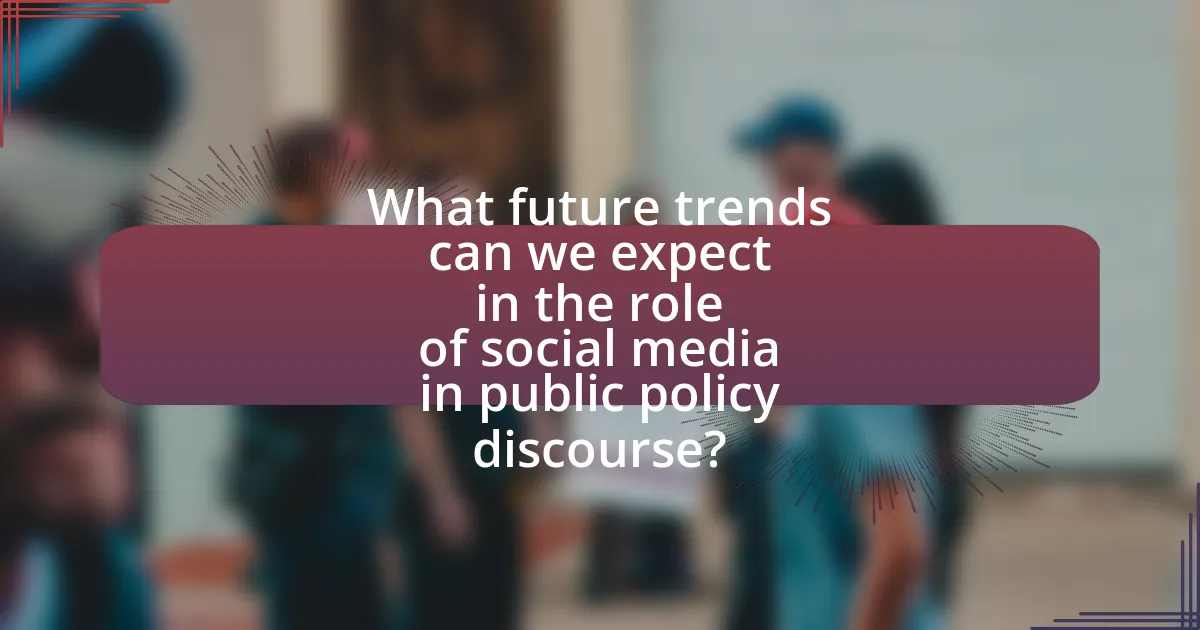
What future trends can we expect in the role of social media in public policy discourse?
Future trends in the role of social media in public policy discourse will likely include increased engagement through real-time feedback mechanisms and the use of data analytics to inform policy decisions. Social media platforms are evolving to facilitate direct communication between policymakers and citizens, allowing for immediate public input on legislative proposals. For instance, studies show that 70% of policymakers now utilize social media to gauge public opinion, indicating a shift towards more participatory governance. Additionally, the integration of artificial intelligence in social media analytics will enable more nuanced understanding of public sentiment, further shaping policy discussions.
How might emerging technologies change the landscape of public policy discussions on social media?
Emerging technologies, such as artificial intelligence and blockchain, are likely to transform public policy discussions on social media by enhancing data analysis and improving transparency. AI can analyze vast amounts of social media data to identify trends and public sentiment, enabling policymakers to respond more effectively to constituents’ needs. For instance, a study by the Pew Research Center found that 69% of adults in the U.S. believe social media is an important platform for political engagement, indicating its growing influence. Additionally, blockchain technology can provide a transparent and secure way to verify information shared on social media, reducing the spread of misinformation that often complicates policy discussions. This combination of advanced analytics and enhanced verification mechanisms will likely lead to more informed and constructive public policy dialogues.
What potential risks and benefits do new platforms present for policy discourse?
New platforms present both risks and benefits for policy discourse. The benefits include increased accessibility and engagement, allowing diverse voices to participate in discussions, which can lead to more representative policymaking. For instance, platforms like Twitter and Facebook have enabled grassroots movements, such as the Arab Spring, demonstrating how social media can mobilize public opinion and influence policy change.
Conversely, the risks involve the spread of misinformation and polarization, which can distort public understanding and hinder constructive dialogue. Research from the Pew Research Center indicates that social media can amplify extreme viewpoints, leading to echo chambers that reduce the likelihood of consensus-building in policy discussions. Thus, while new platforms can enhance democratic engagement, they also pose challenges that must be managed to ensure effective policy discourse.
How can policymakers adapt to the evolving social media environment?
Policymakers can adapt to the evolving social media environment by implementing flexible regulatory frameworks that address the rapid changes in technology and user behavior. These frameworks should prioritize transparency, accountability, and user privacy while fostering innovation. For instance, the European Union’s General Data Protection Regulation (GDPR) serves as a model by establishing clear guidelines for data protection and user consent, which can help policymakers navigate the complexities of social media platforms. Additionally, engaging with diverse stakeholders, including tech companies, civil society, and the public, can provide valuable insights and foster collaborative approaches to policy development.
What practical tips can enhance the effectiveness of social media in public policy discourse?
To enhance the effectiveness of social media in public policy discourse, stakeholders should prioritize clear messaging and audience engagement. Clear messaging ensures that complex policy issues are communicated in an understandable manner, which can increase public comprehension and participation. Engaging with the audience through interactive content, such as polls and Q&A sessions, fosters a two-way dialogue that can lead to more informed public opinions and feedback. Research indicates that posts with visual elements, such as infographics, can increase engagement rates by up to 94%, making information more accessible and shareable. Additionally, utilizing data analytics to track engagement metrics allows policymakers to refine their strategies based on what resonates with the audience, thereby improving the overall impact of their social media efforts.
How can individuals and organizations leverage social media for advocacy?
Individuals and organizations can leverage social media for advocacy by creating targeted campaigns that engage audiences and promote specific causes. These campaigns can utilize hashtags, share compelling stories, and mobilize supporters to take action, such as signing petitions or attending events. For instance, the #MeToo movement effectively used social media to raise awareness about sexual harassment and assault, leading to significant societal and legislative changes. Research indicates that social media can amplify voices and foster community engagement, making it a powerful tool for advocacy efforts.
What are the key considerations for crafting impactful messages on social media regarding policy issues?
Key considerations for crafting impactful messages on social media regarding policy issues include clarity, audience targeting, emotional resonance, and factual accuracy. Clarity ensures that the message is easily understood, which is crucial given the fast-paced nature of social media. Targeting the right audience allows for more effective engagement, as messages can be tailored to specific demographics or interest groups. Emotional resonance helps to connect with the audience on a personal level, making the message more memorable and shareable. Factual accuracy is essential to maintain credibility and trust; misinformation can undermine the message and lead to public backlash. For instance, a study by the Pew Research Center found that 64% of Americans believe that misinformation is a major problem on social media, highlighting the importance of delivering accurate information in policy discussions.
